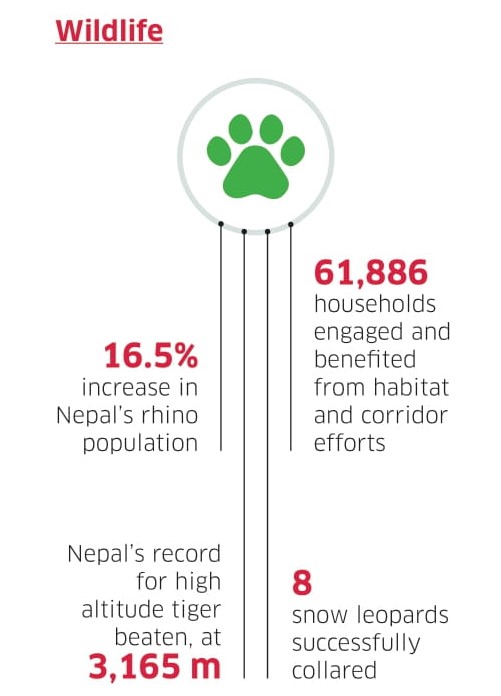WWF Nepal in 2021 ended its USAID-funded Hariyo Ban Program after 10 years. In this period, the program achieved several conservation milestones.
Nepal is on track to achieving the global goal of doubling its tiger numbers as it has recorded tigers at altitudes of 2,500 meters in the west and 3,200 meters in the east.
Similarly, the one-horned rhino count has hit a historic high with 752 counted last year (694 in Chitwan, 38 in Bardiya, 17 in Shuklaphanta and three in Parsa), in what was a 16.5 percent increase from 2015. Nepal also collared two additional snow leopards in Shey Phoksundo National Park.

When covid pandemic led to illegal logging, forest product harvest and wildlife crimes, the program in partnership with government, local communities and stakeholder renewed its efforts to protect forests and wildlife. WWF Nepal alone contributed to the protection of 161,813 hectares of forests by strengthening Forest Conservation Areas (FCA). Also, the authorities concerned maintained guard posts, fire lines, revised policy assistance, and held transboundary meetings with the Indian side to develop a cross-border sharing mechanism.
Efforts were also initiated to reduce fuelwood as the primary source of energy, as it hampers the environment along with the health and safety of communities.
Climate change was another field where the Hariyo Ban Program was active. Climate change has affected multiple small communities in the form of climate-induced disasters such as flooding and riverbank erosion.

To address these problems, the Climate Change Strategy and Action Plan (CCSAP) for each province of Nepal is currently being prepared to localize the National Climate Change Policy that aims to make a transition to 100 percent renewable energy.
Overfishing, proliferation of aquatic invasive species, unmanaged sand and gravel mining, pollution, encroachment, siltation, unplanned infrastructure development and ground water extraction continue to threaten freshwater ecosystems. To cope with these challenges, seven artificial wetlands were constructed and restored in the western Tarai. These wetlands are expected to retain around 200 million liters of underground water.
There has also been work on strengthening indigenous people and local communities’ access to natural resources and ensuring equitable benefit sharing mechanisms by creating transparent, participatory, inclusive governance mechanisms for sustainable management of natural resources.












